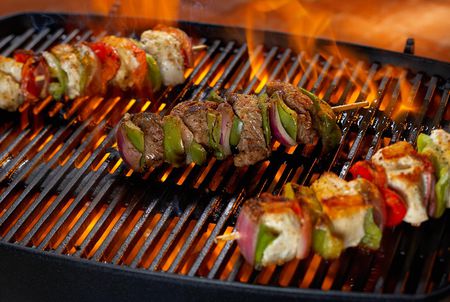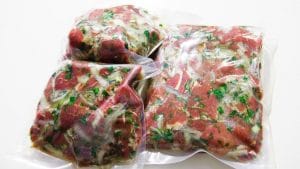Summer grilling is full of fun and all kinds of bright ideas, like the various combinations you can put on a kabob.
But how do you grill the perfect kabob ?
No worries, I’ve got you covered and I’m going to give you a few easy tips so you’ll always know how to do it right.
First, let’s start with the basics.
How to grill kabobs – the basics
You’ll want your grill set to medium-high heat for this. A nice, even medium heat will get you good cooking heat, nice charring on the outside, and not burn your kabobs.
So once you’ve got your kabobs in order, whether they’re meat or vegetables, make sure your grill is hot enough.
Then, place the kabobs on the grill, at a 45 degree angle, so the bits don’t fall between the grates and you get the first part of the criss cross pattern.
Let the kabobs sit on the grill for at least 5 minutes, with the lid on. If you’re cooking meat it will usually take a few minutes longer than vegetables.
Once the 5 minutes are done, open the lid and flip on the other side. Cover again and leave for another 5 minutes. Then open the lid, rotate, and close again until the meat or veg is done.
What you’re looking for when grilling kabobs is the food being done, and getting some nice marks on it as well. A hot enough grill will help a lot, both to cook your food evenly, and to leave some nice grill marks.
The lid should be closed at all times, so the kabobs will also get cooked by the hot air, aside from getting that smoky flavor.
Those are the basics. Next up, we’ll talk about what can go on a kabob, and later I’ll give you a recipe for a nice chicken kabob.
What goes on a kabob/skewer ?
Anything goes on a kabob, really.
As long as you respect cooking times, you can put anything. Even fruit can be put on a kabob, which makes for a very interesting combination.
You can mix meat and vegetables, of course. But make sure to balance out the meat’s cooking time by using thicker slices of vegetables.
Of course, that’s not always possible, so you may need to cook them separately.
For example a light meat, like fish or chicken, will be done about the same time as an inch-thick piece of Portobello mushrooms, or zucchini (about 10-12 minutes).
You can balance things out, which is what most people will try to do in order to make their kabobs as delicious as possible.
But I say marinating your kabobs, the meat ones, will add enough flavor that you can grill the vegetables separately. I’ll get to the marinade in a bit.
Cook vegetables and meat separately
If you’d like to cook your meat and veggies separately, then you’re going to want to know their cook times.
For chicken, turkey, and fish about 10-12 minutes on both sides should be enough. This is assuming you’re using thin, half-inch pieces.
For beef and lamb, you’ll want to use larger pieces since these are meant to be medium, or medium rare.
So you’ll want to leave them on the grill for a total of 7-8 minutes, depending on how much fat marbling the meat has.
As for pork, I recommend you leave that on the grill for longer than all, at least 15 minutes as the flavor can sometimes be off if it’s not very well done.
Vegetables will need less cook time, since most of them can be eaten raw.
For example mushrooms, zucchini, eggplant all cook at about the same rate. They all have a high water content, so you’ll want to leave then for less than 10 minutes.
Corn on the cob, if you feel like sticking it on a skewer, is going to take about 15 minutes and it needs to be rolled on all sides.
Bell peppers, cut into thin slices, will cook about as fast as asparagus and broccoli (or broccoli sprouts), around 7 minutes if you like them to still have a bit of a bite.
If you’re grilling potatoes, which I suggest you do, you need to use cooked potatoes, otherwise you’ll be waiting a long time for them to soften.
As long as you cook them through, but they’re still able to hold their shape when you slice them, they should be okay. Grill them for 10-15 minutes, depending on how crisp you like them.
This also applies for sweet potato, and squash.
Tips for easy grilling kabobs
This is going to be helpful in many ways, but there is no real, straight order to them. Tips and tricks I’ve picked up along the years, so my kabobs end up great. Here they are.
Always leave half an inch between meat bits on the skewer. You can of course cook your meat all bunched up on the skewer. But I recommend you leave a little space, even as the meat is raw. This prevents the meat from overcrowding, which leads to it being less cooked in the parts it meets.
Always soak your wooden skewers or planks before using them. Leave them in cold water for 30-60 minutes before use, so they remain moist and don’t burn while you cook with them.
This also prevents them from catching fire, which may sometimes happen and no one wants that.
If you want to be extra-safe, use metal skewers. Not only are they reusable, but they also have no chance of catching fire. They withstand heat much better than wood, and they’re usually flat instead of round. This means your kabobs’ ingredients won’t slide around and thus will cook exactly the way you want them to.
A great metal skewer set can be found on my Best Metal Skewers page, detailing a 10-piece set which is going to help you with any cookout.
Oil will speed up the grill marks. If you’re trying to grill fat free, kudos to you. But if you’re looking for deep, dark grill marks you’re going to need to apply a bit of fat to that kabob, be it meat or veggie.
For nice, even grill marks turn the kabob every few minutes on all sides. This will ensure you don’t get color on just one side, and will also expose all parts of the kabob to the direct heat coming from the embers.
Wait until each side is marked before turning, otherwise you won’t get them as nice as a restaurant. And if you’re looking for a crosshatch design, simply keep rotating the kabobs at an angle.
When grilling mushrooms, use smaller ones that you won’t need to cut in more than half. This way you can preserve more flavor in your veggie, and it will remain moist enough.
If you’re in a bit of a hurry, or would like to cut back on grilling time, blanching your vegetables before grilling them is a good solution. You’ll get grill marks, smoke, and a well cooked vegetable.
When grilling meat, especially beef or lamb that can get chewy of grill for too long, make sure you marinade the meat for a few hours before. 24 hours is recommended, but if you’re short on time 4 hours is usually good too.
Lemons can be grilled as well, and make for a great flavor when squeezed over grilled fish or other meats. Always make sure to grill half a lemon, cut side down.
When grilling red meat, make sure to bring it up to room temperature for a nice and even grilling experience. So if it’s in the fridge, take it out an hour or two before grilling.
How to grill chicken kabobs
This recipe is a good starting point if you’ve never grilled kabobs before.
Chicken is a very forgiving meat, and it will grill beautifully in all cases, whether you marinate it or not.
I recommend you start out with chicken breast, as that’s the easiest to work with, even if it’s not the most flavorful.
This recipe will yield about 6-8 kabobs, and will be great with any grilled veggie you add as a side dish. You’ll need:
- 1 large, whole chicken breast, boneless and skinless
- 3-4 wooden skewers
- salt, pepper, a shake of cayenne
- olive oil
You’re going to start simply enough, by washing the chicken breast and then patting it dry.
In the meantime, heat up your grill to medium-high.
Back to the chicken breast, cut it into half-inch thick sizes. You can leave them longer, but make sure they’re not larger than 0.5 at their thickest.
Unless your grill’s grates are spaced wider than that, so use that as a reference.
Cut up all the chicken into cubes/rectangles, and make sure to leave about half an inch of space between each piece of meat.
Remember that wooden skewers need to be soaked in water for half an hour before use, so they don’t burn up. Soak a couple more than you need, you might be left with some extra pieces of meat.
Once all the meat has been places on the skewers, thoroughly salt and pepper it, add a bit of cayenne to an extra kick or leave it out if you want.
Drizzle a bit of olive oil onto the skewers, and rub lightly onto the chicken.
Your grill should be hot enough by this point, so once you place the chicken on the grill it should sizzle loudly. If it doesn’t sizzle at all, it’s not ready.
Place your kabobs on the grill at an angle, with respect to the grate. This way you’re getting the first part of the crosshatch marks you might be looking for.
Let the kabobs sit on the grill undisturbed for 5 minutes, with the lid on. After those are done, roll them onto another side, again at an angle, and close the lid again.
After the first 10 minutes, your chicken should be done enough to be safe to eat, if you’ve cut it thinly enough. If you know your chicken’s a bit thicker, or you’d like to be extra sure it’s safe to eat, give it another 3 minutes, rotated on another side.
You’ll know your chicken is done once it’s gone beyond just white, and is starting to get a bit of color around the edges. Some whitish, stringy substance will appear on the meat. That’s alright. That’s just protein and fat combined, it’s edible and happens with any piece of meat.
Once the chicken is done, you can remove it from the grill. If you’d like, you can use that half lemon on the grill tip. It’ll brighten up the chicken, and add some extra flavor to the cayenne or pepper.
This kabob recipe is meant both as an actual recipe, and both as first time try for you to get a grip on how grilling kabobs works.
But if you’re looking to grill a beef of lamb kabob, or even duck, you’ll need marinade for flavor and tenderness.
A great marinade for tougher meats
A marinade will do two things to the meat you want to put on the skewers.
First, it will make sure the meat is full of the flavors you want. You’re going to submerge/slather it in lots of seasoning, so it has no alternative.
Second, it will become more tender and juicy because you’ll be using an acidic substance, like a bit of vinegar, wine, or even lemon juice.
So for example let’s go with a marinade that will go with most red meats, a red wine one.
This marinade is for 1 pound of meat, so feel free to scale it up if you need more. You’ll need:
- 3.5 fl oz dry red wide, any kind as long as it’s drinkable
- double that amount in cooking oil, less if your meat is very fatty
- 1 whole onion, large chunks
- 3-4 cloves garlic, crushed
- 5-6 sprigs fresh rosemary
- salt, pepper to taste (lots)
You’re going to need a big bowl, or a very large Ziploc bag that will fit all the meat and marinade.
In the bowl or bag, throw in all the ingredients. Stir or shake with caution, so as not to get any on yourself.
When you add the meat, you’re going to want to add it pre-cut. This will help the marinade penetrate into the meat even better, on all sides.
Once the meat is in the marinade, cover it with saran wrap and make sure to touch the surface of the meat so nothing is exposed to the air (if you’re using a bowl).
If you’re using a plastic bag, try and squeeze out as much air as possible, and lock the bag. Place it into a bowl anyway, so that if there is any leakage it won’t contaminate the rest of the items in the fridge.
Let the meat marinate for at least 4 hours, up to 24 before grilling. Remove from fridge an hour before grilling.
Conclusion
Grilling kabobs is fun, and it’s always going to remind you of popsicles in some weird way. But eating grilled meat off a stick has a charm of its own, and there’s few other things that say ”summer’s here” than kabobs. Okay, maybe grilled corn.
If you keep trying with your grilling, you’re eventually going to master any kind of kabob. So keep at it !




